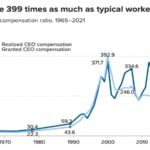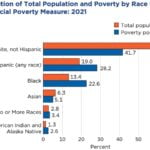CEOs in the U.S. continued making millions while millions became unemployed due to the pandemic in 2020.
Realized income for CEOs in the top 350 publicly owned U.S. companies rose 18.9% last year, bringing their average pay to $24.2 million (up from $21.3 million in 2019), according to an Aug. 10 report published by the Economic Policy Institute (EPI).
When analyzing granted income, the average CEO compensation was $13.9 million, down slightly from $14.5 million in 2019.
“The realized measure of compensation includes the value of stock options as realized (i.e., exercised), capturing the change from when the options were granted to when the CEO invokes the options, usually after the stock price has risen and the options values have increased,” EPI explained. “The granted measure of compensation values stock options and restricted stock awards by their ‘fair value’ when granted.”
Among U.S. workers who retained employment throughout the pandemic, income rose 3.9% — 15-points lower than the increase of the top 350 CEOs last year.
Yet, EPI notes that this doesn’t fully capture the disparity, because the significant number of low-income wage earners who lost their jobs in 2020 “skewed the average wage higher.”
Since 1978, realized compensation for CEOs has risen more than 1,300%, while granted compensation increased by just over 970%. During this period, the average worker saw an 18% increase in compensation.
Using the realized compensation data, EPI calculates that CEOs were paid 351 times more than the average U.S. worker in 2020. While this is down from a high of 386 times more in 2000, it remains well above the 15-1 ratio in 1965.
Even the highest paid workers (the top 0.1% of U.S. workers) can’t keep pace, as the top 350 CEO’s realized compensation is 6.44 times higher than this group. By comparison, from 1947-1979, average CEO pay was only 3.18 times higher than the top 0.1% of wage earners.
“The escalation of top CEO compensation further exacerbates the inequalities that have grown for four decades and been amplified in the pandemic. CEOs offering pay cuts during the pandemic yielded favorable headlines but were symbolic at best and a head fake at worst,” said Lawrence Mishel, EPI Distinguished Fellow and co-author of the report, in a press release announcing the findings. “Rising pay for CEOs and other executives is income that would otherwise have gone to others—what these executives earned was not available for broader-based wage growth for typical workers.”
Founded in 1986, EPI describes itself as “a nonprofit, nonpartisan think tank created … to include the needs of low- and middle-income workers in economic policy discussions.”
The full report is available here.
Editor’s note: This is the final article in a series this week for Labor Day 2021 (Sept. 6). The other articles in the series are:
Giving Me a Break | Starlette Thomas
U.S. Labor History Filled with Days of Infamy and Pride | Chris Sanders





